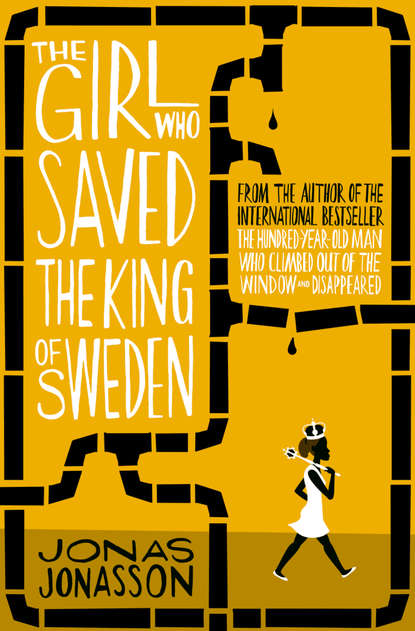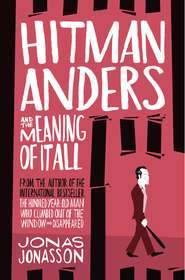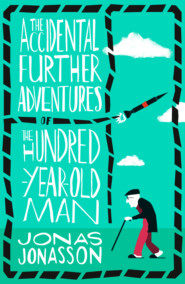По всем вопросам обращайтесь на: info@litportal.ru
(©) 2003-2024.
✖
The Girl Who Saved the King of Sweden
Автор
Год написания книги
2018
Настройки чтения
Размер шрифта
Высота строк
Поля
Engineer Westhuizen’s servant relapsed into the distant hope that a general societal change would come to her rescue. But it wasn’t easy for her to predict the chances of anything that might give her a future at all, whatever the quality of that future might be.
The books in the library of the research facility gave her some context, of course, but most of what was on the shelves was ten or more years old. Among other things, Nombeko had skimmed through a two-hundred-page document from 1924 in which a London professor considered himself to have proved that there would never be another war, thanks to a combination of the League of Nations and the spread of the increasingly popular jazz.
It was easier to keep track of what was going on within the fences and walls of the facility. Unfortunately the latest reports said that the engineer’s clever colleagues had solved the autocatalytic issue and others besides, and they were now ready for a test detonation. A successful test would bring the whole project far too close to completion for Nombeko’s comfort, because she wanted to keep living for a while longer.
The only thing she could do there and then was try to slow their progress down a bit. Preferably in such a way that the government in Pretoria would not start to suspect that Westhuizen was as useless as he was. Perhaps it would be enough to put a temporary stop to the drilling that had just begun in the Kalahari Desert.
Even though things had gone as they had with the antifreeze, Nombeko once again turned to the Chinese girls for help. She asked if she could send a letter through them, via the girls’ mother. How did that all work, by the way? Wasn’t outgoing post checked at all?
Yes, of course it was. There was a white on the guard staff who did nothing but go through everything that wasn’t being sent to an addressee who already had security clearance. At the least suspicion he would open the outgoing post. And he would interrogate the sender, no exceptions.
This would, of course, have been an insurmountable problem if the director of security hadn’t held a briefing a few years ago with those responsible for the post. Once he had told the Chinese girls in great detail about the security measures in place, adding that such measures were necessary because not a single person could be trusted, he excused himself to go to the bathroom. Whereupon the Chinese girls proved him right: as soon as they were alone in the room, they skipped around his desk, fed the correct paper into the typewriter, and added another addressee with security clearance to the 114 that already existed.
‘Your mother,’ said Nombeko.
The girls smiled and nodded. To be on the safe side, they had given their mother a nice title before her name. Cheng Lian looked suspicious. Professor Cheng Lian inspired confidence. The logic of racism was no more complicated than that.
Nombeko thought that a Chinese name ought to have caused someone to react, even with the title of professor, but taking risks and getting away with them seemed once and for all to be part of the girls’ nature – aside from the reason they were as locked up as she was. And the name had already been working for several years, so it ought to work for one more day. So did this mean that Nombeko could send a letter in a letter to Professor Cheng Lian, and the girls’ mother would forward it?
‘Absolutely,’ said the girls, showing no curiosity about whom Nombeko wanted to send a message to.
To:
President James Earl Carter Jr
The White House, Washington
Hello, Mr President. You might be interested to know that South Africa, under leadership of a regularly intoxicated ass, is planning to detonate one atomic bomb of approximately three megatons within the next three months. This will take place in early 1978 in the Kalahari Desert, more specifically, at these exact coordinates: 26°44′26″S, 22°11′32″E. Afterwards, the plan is for South Africa to equip itself with five more of the same type, to use as it sees fit.
Sincerely,
A Friend
Wearing rubber gloves, Nombeko closed the envelope, addressed it and added ‘Death to America!’ in one corner. Then she put it all in another envelope that was expedited the very next day to a professor in Johannesburg who had security clearance and a Chinese-sounding name.
* * *
The White House in Washington was constructed by black slaves imported from Nombeko’s Africa. It was a majestic building from the start, and it was even more impressive 177 years later. The building contained 132 rooms, 35 bathrooms, 6 levels, a bowling alley and a cinema. And an awful lot of staff, who between them received more than thirty-three thousand pieces of post per month.
Each one was X-rayed, subjected to the sensitive noses of specially trained dogs, and visually inspected before they went to each individual recipient.
Nombeko’s letter made it through both X-ray and dogs, but when a sleepy yet observant inspector saw ‘Death to America’ on an envelope addressed to the president himself, the alarm was sounded. Twelve hours later, the letter had been flown to Langley, Virginia, where it was shown to CIA director Stansfield M. Turner. The debriefing agent described the envelope and informed him that the fingerprints on it were limited in extent and placed in such a way that they were unlikely to lead to anything more than various postal workers; that the letter had not caused the radiation sensors to react; that the postmark appeared to be authentic; that it had been sent from postal zone nine in Johannesburg, South Africa, eight days earlier; and that a computer analysis indicated that the text had been formed from words cut out of the book Peace on Earth, which had been written by a British professor who first argued that the combination of the League of Nations and jazz would bring good fortune to the world and then, in 1939, took his own life.
‘Jazz is supposed to bring peace on earth?’ was the CIA director’s first comment.
‘Like I said, sir, he took his own life,’ the agent answered.
The CIA director thanked the agent and was left alone with the letter. Three phone calls and twenty minutes later, it was clear that the contents of the letter were in complete agreement with the information he had, embarrassingly enough, received from the Soviets three weeks earlier but had not believed at the time. The only difference was the exact coordinates in the anonymous letter. All in all, the information appeared to be extremely credible. Now there were two main thoughts in the CIA director’s head:
Who the hell had sent the letter?
Time to contact the president. The letter had been addressed to him, after all.
Stansfield M. Turner was not popular at the agency because he was trying to exchange as many of his colleagues as possible for computers. And it was one of them – not a person – that had been able to trace the cut-out words to the book Peace on Earth.
‘Jazz is supposed to bring peace on earth?’ said President Carter to his old schoolmate Turner when they met the next day in the Oval Office.
‘He took his own life a few years later, Mr President,’ said the director of the CIA.
President Carter – who loved jazz – still couldn’t let the thought go. What if the poor professor had been right? And then the Beatles and the Rolling Stones showed up and ruined everything?
The director of the CIA said that the Beatles could be blamed for a lot of things, but not for starting the Vietnam War. And then he said that he was sceptical of the theory, because if the Beatles and Rolling Stones hadn’t already destroyed peace on earth, there was always the Sex Pistols.
‘The Sex Pistols?’ the president wondered.
‘“God Save the Queen”, you remember?’ the CIA director quoted.
‘Oh, I see,’ said the president.
Now to the question at hand. Were the idiots in South Africa about to detonate an atomic bomb? And was this work being led by an ass?
‘I don’t know about the ass part, sir. We have indications that the work is being supervised by an Engineer Westhuizen, who graduated with top grades from one of South Africa’s best universities. He must have been handpicked.’
But there were many indications that the rest of the information was correct. The KGB had, of course, already been so kind as to tip them off about what was going on. And now this letter, formulated in such a way that the CIA director was prepared to bet his life that the KGB wasn’t behind it this time. Plus, the CIA’s own satellite images showed activity in the desert exactly where the mystery sender said it would be.
‘But why this “Death to America” on the envelope?’ said President Carter.
‘It meant that the letter landed on my desk immediately, and I think that was the point. The letter writer seems to have great insight into how security around the president works. That makes us even more curious about who he is. Cleverly executed, in any case.’
The president hemmed and hawed. He had trouble seeing what was so clever about ‘Death to America’. Or, for that matter, the assertion that Elizabeth II was of any race other than the human one.
But he thanked his old friend and asked his secretary to call up Prime Minister Vorster in Pretoria. President Carter was directly responsible for 32,000 nuclear missiles that pointed in a number of directions. Brezhnev in Moscow was in a similar situation. The world did not need another six weapons of the same magnitude. Someone was going to get a talking-to!
* * *
Vorster was furious. The president of the United States, that peanut farmer and Baptist, had had the nerve to call and claim that preparations were under way for a weapons test in the Kalahari Desert. Furthermore, he had recited the coordinates of the exact location of the test site. The accusation was completely baseless and incredibly, terribly insulting! In a rage, Vorster slammed down the phone in Jimmy Carter’s ear, but he had enough sense not to go any further. Instead he called Pelindaba right away to order Engineer Westhuizen to test his weapons somewhere else.
‘But where?’ said Engineer Westhuizen while his cleaning woman swabbed the floor around his feet.
‘Anywhere but the Kalahari,’ said Prime Minister Vorster.
‘That will delay us by several months, maybe a year or more,’ said the engineer.
‘Just do as I say, dammit.’
* * *
The engineer’s servant let him spend two whole years thinking about where the weapons test could be done, now that the Kalahari Desert was no longer available. The best idea Westhuizen had was to shoot the thing off in one of the many homelands, but not even he thought this sounded good enough.







